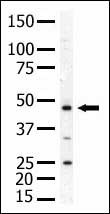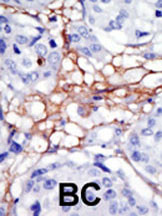PIP4KII-alpha (PIP4K2A) Antibody (N-term)
Purified Rabbit Polyclonal Antibody (Pab)
- SPECIFICATION
- CITATIONS
- PROTOCOLS
- BACKGROUND

Application
| IHC-P, WB, E |
|---|---|
| Primary Accession | P48426 |
| Other Accession | Q9R0I8, O70172 |
| Reactivity | Human, Mouse |
| Predicted | Rat |
| Host | Rabbit |
| Clonality | Polyclonal |
| Isotype | Rabbit IgG |
| Calculated MW | 46225 Da |
| Antigen Region | 107-139 aa |
| Gene ID | 5305 |
|---|---|
| Other Names | Phosphatidylinositol 5-phosphate 4-kinase type-2 alpha, 1-phosphatidylinositol 5-phosphate 4-kinase 2-alpha, Diphosphoinositide kinase 2-alpha, PIP5KIII, Phosphatidylinositol 5-phosphate 4-kinase type II alpha, PI(5)P 4-kinase type II alpha, PIP4KII-alpha, PtdIns(4)P-5-kinase B isoform, PtdIns(4)P-5-kinase C isoform, PtdIns(5)P-4-kinase isoform 2-alpha, PIP4K2A, PIP5K2, PIP5K2A |
| Target/Specificity | This PIP4KII-alpha(PIP4K2A) antibody is generated from rabbits immunized with a KLH conjugated synthetic peptide between 107-139 amino acids from the N-terminal region of human PIP4KII-alpha(PIP4K2A). |
| Dilution | WB~~1:1000 IHC-P~~1:50~100 |
| Format | Purified polyclonal antibody supplied in PBS with 0.09% (W/V) sodium azide. This antibody is prepared by Saturated Ammonium Sulfate (SAS) precipitation followed by dialysis against PBS. |
| Storage | Maintain refrigerated at 2-8°C for up to 2 weeks. For long term storage store at -20°C in small aliquots to prevent freeze-thaw cycles. |
| Precautions | PIP4KII-alpha (PIP4K2A) Antibody (N-term) is for research use only and not for use in diagnostic or therapeutic procedures. |
| Name | PIP4K2A (HGNC:8997) |
|---|---|
| Function | Catalyzes the phosphorylation of phosphatidylinositol 5- phosphate (PtdIns5P) on the fourth hydroxyl of the myo-inositol ring, to form phosphatidylinositol 4,5-bisphosphate (PtdIns(4,5)P2) (PubMed:23326584, PubMed:9367159). Has both ATP- and GTP-dependent kinase activities (PubMed:26774281). May exert its function by regulating the levels of PtdIns5P, which functions in the cytosol by increasing AKT activity and in the nucleus signals through ING2 (PubMed:18364242). May regulate the pool of cytosolic PtdIns5P in response to the activation of tyrosine phosphorylation (By similarity). Required for lysosome-peroxisome membrane contacts and intracellular cholesterol transport through modulating peroxisomal PtdIns(4,5)P2 level (PubMed:29353240). In collaboration with PIP4K2B, has a role in mediating autophagy in times of nutrient stress (By similarity). Required for autophagosome-lysosome fusion and the regulation of cellular lipid metabolism (PubMed:31091439). May be involved in thrombopoiesis, and the terminal maturation of megakaryocytes and regulation of their size (By similarity). Negatively regulates insulin signaling through a catalytic-independent mechanism (PubMed:31091439). PIP4Ks interact with PIP5Ks and suppress PIP5K-mediated PtdIns(4,5)P2 synthesis and insulin-dependent conversion to PtdIns(3,4,5)P3 (PubMed:31091439). |
| Cellular Location | Cell membrane {ECO:0000250|UniProtKB:O70172}. Nucleus. Lysosome {ECO:0000250|UniProtKB:O70172}. Cytoplasm. Photoreceptor inner segment {ECO:0000250|UniProtKB:O70172}. Cell projection, cilium, photoreceptor outer segment {ECO:0000250|UniProtKB:O70172}. Note=May translocate from the cytosol to the cell membrane upon activation of tyrosine phosphorylation. May translocate from the inner to the outer segments of the rod photoreceptor cells in response to light (By similarity) Localization to the nucleus is modulated by the interaction with PIP4K2B. {ECO:0000250|UniProtKB:O70172, ECO:0000269|PubMed:20583997} |
| Tissue Location | Expressed ubiquitously, with high levels in the brain. Present in most tissues, except notably skeletal muscle and small intestine. |

Thousands of laboratories across the world have published research that depended on the performance of antibodies from Abcepta to advance their research. Check out links to articles that cite our products in major peer-reviewed journals, organized by research category.
info@abcepta.com, and receive a free "I Love Antibodies" mug.
Provided below are standard protocols that you may find useful for product applications.
Background
Phosphatidylinositol-4,5-bisphosphate, the precursor to second messengers of the phosphoinositide signal transduction pathways, is thought to be involved in the regulation of secretion, cell proliferation, differentiation, and motility. TPIP5K2A is one of a family of enzymes capable of catalyzing the phosphorylation of phosphatidylinositol-4-phosphate on the fifth hydroxyl of the myo-inositol ring to form phosphatidylinositol-4,5-bisphosphate. The amino acid sequence of this enzyme does not show homology to other kinases, but the recombinant protein does exhibit kinase activity. The protein is a member of the phosphatidylinositol-4-phosphate 5-kinase family.
References
Rozenvayn, N., et al., J. Biol. Chem. 278(10):8126-8134 (2003).
Boronenkov, I.V., et al., J. Biol. Chem. 270(7):2881-2884 (1995).
Loijens, J.C., et al., Adv. Enzyme Regul. 36, 115-140 (1996).
Divecha, N., et al., Biochem. J. 309 (Pt 3), 715-719 (1995).
If you have used an Abcepta product and would like to share how it has performed, please click on the "Submit Review" button and provide the requested information. Our staff will examine and post your review and contact you if needed.
If you have any additional inquiries please email technical services at tech@abcepta.com.













 Foundational characteristics of cancer include proliferation, angiogenesis, migration, evasion of apoptosis, and cellular immortality. Find key markers for these cellular processes and antibodies to detect them.
Foundational characteristics of cancer include proliferation, angiogenesis, migration, evasion of apoptosis, and cellular immortality. Find key markers for these cellular processes and antibodies to detect them. The SUMOplot™ Analysis Program predicts and scores sumoylation sites in your protein. SUMOylation is a post-translational modification involved in various cellular processes, such as nuclear-cytosolic transport, transcriptional regulation, apoptosis, protein stability, response to stress, and progression through the cell cycle.
The SUMOplot™ Analysis Program predicts and scores sumoylation sites in your protein. SUMOylation is a post-translational modification involved in various cellular processes, such as nuclear-cytosolic transport, transcriptional regulation, apoptosis, protein stability, response to stress, and progression through the cell cycle. The Autophagy Receptor Motif Plotter predicts and scores autophagy receptor binding sites in your protein. Identifying proteins connected to this pathway is critical to understanding the role of autophagy in physiological as well as pathological processes such as development, differentiation, neurodegenerative diseases, stress, infection, and cancer.
The Autophagy Receptor Motif Plotter predicts and scores autophagy receptor binding sites in your protein. Identifying proteins connected to this pathway is critical to understanding the role of autophagy in physiological as well as pathological processes such as development, differentiation, neurodegenerative diseases, stress, infection, and cancer.



